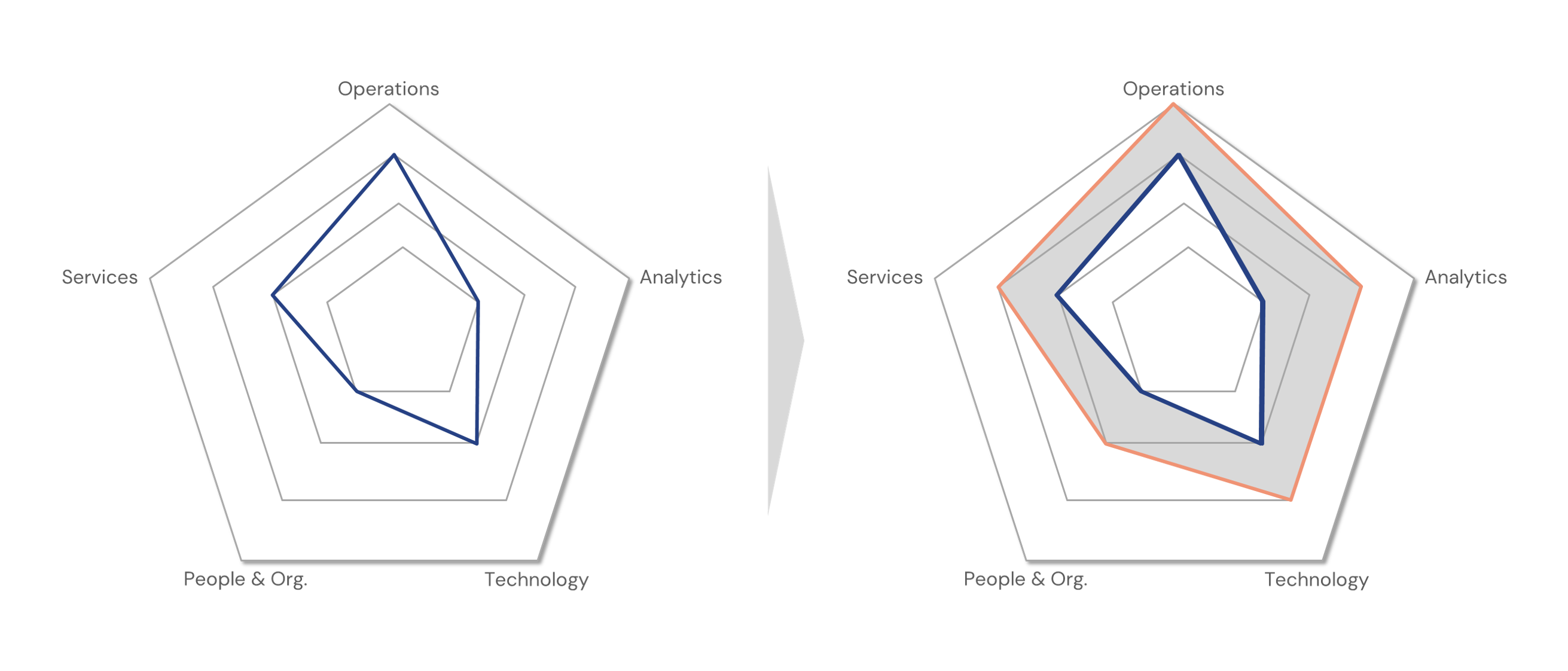As we began exploring in our previous insight, a successful DX requires a deliberate strategy that goes beyond adopting new technologies; it demands the integration of organizational capabilities and technologies, cultural shifts, and the continuous improvement of operations and customer experiences.
Building on our strategic planning expertise spanning industries like financial services, healthcare and procurement, we developed a five-step framework to navigate the challenges of DX and create lasting value: (1) conduct a Digital Maturity Assessment (DMA), (2) define clear goals, (3) develop a tailored strategy, (4) implement initiatives with precision, and (5) recalibrate strategies through ongoing feedback and review.
V2A’s Digital Maturity Assessment serves as a holistic tool that, in conjunction with a thorough interview process, guides a successful DX in a granular and data driven manner.
The Importance of a Strategic Approach
Effective digital transformation is anchored in a structured approach that evolves with the organization’s needs. Our five-step methodology develops a living roadmap to guide organizations from their current state to their aspirational goals. By integrating stakeholder engagement and data-driven decision-making, this methodology ensures alignment and commitment throughout the DX journey.

The Five Steps of Digital Transformation Strategy:
- Digital Maturity Assessment (DMA): Understand the organization’s current state across five key pillars, discussed below.
- Goal Setting: Define actionable and measurable objectives to seize opportunities by leveraging strengths, or build capabilities to address your weaknesses or mitigate threats.
- Strategy Development: Design initiatives that will help bridge the gaps between your current Digital Maturity level and your goals, with clear responsibilities and investment needs.
- Strategy Implementation: Execute the strategy and turn it into part of the regular operation, leveraging project and performance management tools, and governance and stakeholder collaboration.
- Review & Recalibration: Continuously measure progress and refine strategies based on outcomes.
This article presents the DMA not just as an initial step but as the backbone of digital transformation, ensuring agility, strategic alignment, and continuous progress throughout the entire process. It provides a clear and practical perspective that is necessary to set the right goals, pinpoints critical areas for improvement, and provides ongoing insights into an organization’s progress, serving as the driving force behind successful DX both during and after implementation.
Leveraging the Digital Maturity Assessment
The DMA is a fundamental tool for shaping a successful DX strategy. It assesses an organization’s readiness, performance and compliance across five key pillars, offering a clear snapshot of its digital landscape. The insight it enables is crucial for identifying gaps, capitalizing on strengths, and setting priorities effectively.
The five pillars evaluated in the DMA are:
- Operations – Efficiency and digital integration in core business processes.
- Service Offerings – Digital enablement of products and services.
- Analytics – Data utilization for decision-making and strategic insights.
- People and Organization – Workforce digital skills and cultural adaptability.
- Technology – Infrastructure, tools, and system connectivity.
The assessment combines a detailed survey completed by senior leaders and subject matter experts with stakeholder interviews to capture practical insights and ensure accuracy. Each pillar is subdivided into further dimensions, enabling a granular view of the organization’s digital efforts. Results are presented in a spider chart, highlighting the organization’s maturity across all pillars and dimensions.

Maturity as a Measure of Integration
To ensure a consistent evaluation of an organization’s digital maturity, we assess the degree of digital integration across five key pillars. As an organization progresses in maturity, the adoption of digital tools naturally increases. However, true digital maturity is not merely about using advanced technologies – it is about integrating them effectively to enhance strategy, optimize processes, and anticipate future challenges. The goal is to eliminate technological silos, ensuring that all pillars work cohesively to develop a unified and efficient digital strategy.
After assessing organizations across industries during our engagements, we defined a four-level progression ladder for digital maturity, as seen in Figure 3. Designed for simplicity and clarity, each level represents a deeper integration of digital capabilities.

- Basic – The organization relies on manual processes or rudimentary uses of technology, with minimal system integration. Digital tools are used sporadically, data remains fragmented, and decision-making is intuition-based rather than data-driven. Initiatives are isolated and lack alignment with broader strategic goals.
- Emerging – Digital tools are adopted in specific areas, but remain siloed or outdated, limiting cross-functional collaboration. Some departments improve localized efficiencies, but integration is minimal, and digital investments are often reactive rather than strategic.
- Proficient – Digital systems are partially integrated, improving workflows and collaboration. Data flows between systems, enhancing decision-making, though gaps still exist. Digital transformation is a recognized priority, but adoption is inconsistent across the organization.
- Advanced – The organization achieves full digital integration, with seamless connectivity between systems, departments, and data sources. Digital tools drive strategic decisions, leveraging predictive analytics, automation, and AI to enhance agility and efficiency. The organization operates as a digital enterprise, continuously adapting to new technologies and market shifts.
By structuring digital maturity around integration rather than mere adoption, the DMA becomes a critical tool not only for assessing the current state but for guiding the entire strategic transformation process.
Using the DMA to Define Goals
The DMA is not just a diagnostic tool; it is a catalyst for goal setting. By uncovering key deficiencies and opportunities across all pillars, the DMA equips organizations with data-driven insights to establish strategic objectives. For instance, if the assessment reveals low maturity in operations, a goal might focus on automating manual processes to improve efficiency. Similarly, weaknesses in analytics could inspire objectives to enhance data collection and visualization capabilities.
Effective goal setting involves translating these insights into actionable outcomes. This is often achieved through Objectives and Key Results (OKRs), which provide a structured framework for tracking progress. For example, an organization might set an objective to increase digital integration within three years, with key results tied to measurable improvements in process efficiency, customer satisfaction, or data accuracy.
Developing a Strategy with the DMA
Once goals are established, the DMA serves as a guide for crafting a detailed DX strategy. By offering a granular perspective of organizational capabilities, via a dimensional analysis of each pillar, it enables leaders to prioritize initiatives that address specific pain points. This approach ensures that strategies are not generic but tailored to the unique needs of the organization.
For example, the DMA might highlight the need for improved technology infrastructure, prompting initiatives to modernize systems or establish partnerships with technology providers. Similarly, if the assessment indicates a lack of digital skills within the workforce, the strategy could include targeted training programs to close this gap.
Implementing and Recalibrating the Strategy
The DMA continues to play a vital role during the implementation and recalibration phases of DX. By providing a baseline against which progress can be measured, it ensures that organizations remain focused on their strategic objectives. Implementation involves translating the strategy into action, using tools such as project management dashboards and agile methodologies to track progress and adapt to challenges.
As the organization evolves, the DMA facilitates regular reviews to recalibrate the strategy. Recurring evaluations allow leaders to assess the effectiveness of initiatives, refine goals, and respond to changing market conditions. This feedback loop ensures that the DX strategy remains dynamic and aligned with the organization’s vision.
Conclusion
The Digital Maturity Assessment (DMA) is far more than a diagnostic tool—it is a dynamic enabler of successful digital transformation. By offering a comprehensive evaluation of an organization’s readiness across key pillars, the DMA provides the clarity and direction needed to set actionable goals, develop tailored strategies, and measure progress effectively. Its role extends beyond the initial phases of DX, serving as a continuous guide for recalibrating strategies and driving sustained improvements.
When integrated into a structured, five-step framework, the DMA empowers organizations to navigate the complexities of digital transformation with precision. It ensures that efforts are data-driven, stakeholder-aligned, and adaptable to evolving needs, helping organizations achieve tangible outcomes and lasting value. For those seeking to unlock the full potential of digital transformation, the DMA is an indispensable tool to shape, implement, and sustain impactful change.
We invite our readers to explore our series of articles, where our Digital and Operational Excellence Practice will dive deeper into each driver and provide actionable steps to help business leaders succeed in their own digital transformation journeys. For more information or to schedule a meeting with one of our experts you can email us at adrianperez@v2aconsulting.com or leave us a message in www.v2aconsulting.com/contactus.
 Adrián Pérez
Adrián Pérez Marcel Morales Torres
Marcel Morales Torres

